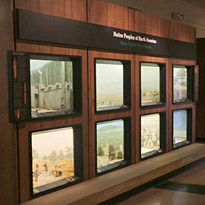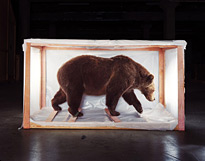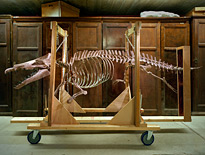Home // Exhibitions // 2009 Exhibitions
2009 Exhibitions
U-M Exhibit Museum of Natural History
"Native American Dioramas in Transition"
September 12, 2009 - January 4, 2010

Museums worldwide are wrestling with questions about the representation of indigenous people in museum exhibits. Who gets to decide how a people's culture is portrayed? Does context matter? What happens when members of a community speak out against museum exhibits?
The U-M Exhibit Museum of Natural History has a set of fourteen dioramas depicting Native American cultures. The dioramas are now almost fifty years old and are longtime favorites of many museum visitors. Both Native and non-Native visitors have spoken out eloquently against them. After years of trying to reconcile these differences through changes to the exhibits and new educational programs, the Museum has decided to remove them from display in January 2010. An interpretive exhibit overlay explains the reasons for the coming change, discusses how other museums have addressed similar issues, and provides an opportunity for comment. Numerous educational events throughout the fall will provide an opportunity to explore these issues in greater depth.
Richard Barnes
Installations, Exhibitions, Explorations
Acclaimed photographer Richard Barnes looks critically at the natural world and the ways in which museums attempt to find and construct meaning through objects. His explorations of the deeply human impulse to collect, preserve, and interpret objects is being presented in three interconnected exhibitions at regional institutions – Cranbrook Institute of Science (in collaboration with Cranbrook Art Museum), the Institute for the Humanities at the University of Michigan, and the University of Michigan Museum of Art – supported by a lively series of educational programs as well as a related exhibition at the Exhibit Museum of Natural History at the University of Michigan.
These exhibitions and events coincide with the University of Michigan's Theme Year, Meaningful Objects: Museums in the Academy, which will explore how museums in an academic setting contribute to knowledge, act as stewards of culture, and provide a public face for research. Courses, lectures, symposia, and explorations of the University's many diverse collections – both public and "hidden" – will offer UM students and the public alike rich opportunities to consider how and why objects become meaningful.
- September 12 - December 16
(Un)Natural History: The Museum Unveiled - October 7
Panel Discussion: "(Un)Natural History and the Power of Display" - September 17 - October 30
Past Perfect/Future Tense: Authenticity and Replication - September 17
Excavations and Iterations: The Museum Unveiled - October 4 - January 3
Animal Logic: Photography and Installation by Richard Barnes
September 12 - December 16
University of Michigan Museum of Art
(Un)Natural History: The Museum Unveiled

Introducing its recent publication of Barnes's behind-the-scenes work in natural history museums, the Princeton Architectural Press says:
Through his lens, sights and objects normally hidden from public view-half-installed dioramas, partially wrapped specimens, anatomical models, exploded skulls, and taxidermied animals in shipping crates-take on a strange beauty... Animal Logic investigates both the human desire to construct artificial worlds for "the wild" and the haunting and poignant worlds the real wild constructs.
This presentation of images from the Animal Logic series includes arresting views of the Smithsonian Institution, the Museum of Comparative Anatomy in Paris, the Canadian Museum of Natural History, and the San Francisco Academy of Sciences, reflecting the artist's longstanding fascination with museum practice, display, and the power of objects in and out of context.
Free and open to the public.
Related Event:
Wednesday, October 7
7:30pm, Helmut Stern Auditorium, University of Michigan Museum of Art
Wednesday Night Museums Lecture
Panel Discussion: (Un)Natural History and the Power of Display
Artist Scott Hocking works with the devastated urban landscape of Detroit to create powerful installations that speak to the ways in which ruined cities become museums of natural history. Richard Barnes concentrates on the museum practice of encasing animals and human beings in vitrines- another sort of a crypt or ruin. Michael Stafford, Director of Cranbrook Institute of Science, creates impactful, socially relevant natural history experiences for museum visitors. Join them in a wide-ranging conversation moderated by Daniel Herwitz, Director of the University of Michigan Institute for the Humanities, who will also lend his own perspectives.
September 17 - October 30
Institute for Humanities Gallery, 202 South Thayer Street, Ann Arbor
Past Perfect/Future Tense: Authenticity and Replication

The Institute for the Humanities 2009 Paula and Edwin Sidman Fellow in the Arts Richard Barnes presents innovative new work inspired by the University of Michigan Exhibit Museum and the collections of the Museums of Paleontology, Anthropology, and Zoology.
In this unique installation, Barnes considers the nature of things from collection and display to extinction. A prehistoric skeletal whale is juxtaposed with a mound of rubber molds and resin casts, examining questions of replication and authenticity, what we save and what we lose. Both lyrical and visceral, Barnes's work engages us in a provocative conversation about museological practice from behind the scenes, capturing the inextricable relationship between human gesture and the inevitability of extinction.
Free and open to the public.
Opening Reception
Thursday, September 17, 6:30 - 8:00pm
A reception with the artist immediately follows the Penny Stamps Distinguished Speakers Series. For more information contact Amanda Krugliak at mandak@umich.edu or 734.936.3518.
Thursday, September 17, 5:10pm
Michigan Theater, 603 East Liberty Street, Ann Arbor
"Excavations and Iterations: The Museum Unveiled"
The Penny Stamps Distinguished Speakers Series, School of Art and Design
The Penny Stamps Distinguished Speakers Series brings respected emerging and established artists and designers from a broad spectrum of media to conduct a public lecture and engage with students, faculty, and the larger University and Ann Arbor communities. This lecture will center on Barnes's work as the 2009 Sidman Fellow for the Arts at the Institute for the Humanities as well as his experiences creating the exhibitions and installations featured here.
Free and open to the public.
Opening Reception
Thursday, September 17, 6:30 - 8:00pm
A reception with the artist immediately follows the Penny Stamps Distinguished Speakers Series. For more information contact Amanda Krugliak at mandak@umich.edu or 734.936.3518.
October 4, 2009 - January 3, 2010
Cranbrook Institute of Science, Cranbrook Art Museum, 39221 Woodward Avenue, Bloomfield Hills
Animal Logic: Photography and Installation by Richard Barnes
This multifaceted, mid-career retrospective will showcase work from all of Richard Barnes's major recent photographic series, including Animal Logic, engaging and at times surreal images of dioramas and artifacts from natural history museums, and Refuge, which focuses on the "hybrid architecture" of urban bird nests that incorporate the detritus of human life. Barnes's images of articulated skeletons as well as new photography and installations utilizing the extensive anthropology, ornithology, and paleontology collections of Cranbrook Institute of Science are also included.
A highlight of the installation is the acclaimed project Murmur, a collaboration between Barnes, Berlin-based video artist Alex Schweder, and Birmingham, Alabama, composer Charles Norman Mason. This integrated photographic, projected video, and composed sound installation draws upon their study of starling migration in Rome and the abstracted and rich forms that exist in this seasonal natural phenomenon. Murmur has been featured in publications as diverse as the New York Times, Audubon Magazine, and Artforum.
These installations and exhibitions were organized by Cranbrook Art Museum, which is closed this year for construction, and Cranbrook Institute of Science, and are part of a pioneering year of collaborative exhibitions and programs called Artology: The Fusion of Art and Science at Cranbrook, generously supported by the Community Foundation for Southeast Michigan, the Erb Family Foundation, and MASCO Corporation Foundation.
Related Events:
Members' Reception
Saturday, October 3, 4:00 - 8:00pm
Members of Cranbrook Art Museum and Cranbrook Institute of Science are invited to meet Richard Barnes. Family activities from 4-6 pm, Cash bar from 6-8 pm. For membership information, call 248.645.3333.
Art Detroit Now Reception
Saturday, October 3, 6:00 - 8:00pm
For more information visit: www.artdetroitnow.com
Artist's Talk and Book Signing
Sunday, October 4, 3:00pm
Cranbrook Institute of Science Auditorium
Lecture is free with paid Museum admission. Copies of the artist's book Animal Logic (Princeton Architectural Press, 2009) available for purchase.
About the Artist
Work by New York-based photographer Richard Barnes has been shown in solo exhibitions at such institutions as the Museum of Photographic Arts in San Diego, the George Eastman House/International Center for Photography, and the Carnegie Museum of Art in Pittsburgh, and can be found in numerous public and private collections, including the Metropolitan Museum of Art, the Philadelphia Museum of Art, the San Francisco Museum of Modern Art, and the Hirshhorn Museum and Sculpture Garden. Barnes has lectured extensively, including at the Graduate School of Design at Harvard University, Parsons School of Art in Manhattan, and the San Francisco Museum of Modern Art. He served as adjunct professor/visiting artist at the San Francisco Art Institute and has taught at the California College of the Arts in San Francisco.
Barnes was a recipient of the Rome Prize for 2005-2006 and his photographs of the cabin of Ted Kaczynski, aka the "Unabomber," were featured in the 2006 Whitney Biennial and awarded the Alfred Eisenstadt Award for Photography. A monograph of his work entitled Animal Logic will be published in September 2009 by Princeton Architectural Press.
For more on Richard Barnes' work visit: www.richardbarnes.net

